Dentist SEO: The Importance of Backlinks and What Kind of Links to Target
How many dentists practice in the US?
It’s a tricky one, right? Take a wild guess.
50,000? Nope.
100,000? Not quite.
As of 2023, there are a whopping 185,897 dental businesses in the US.
To a layperson, this is a boring fact. To a dentist, this is an alarming statistic that emphasizes the competitiveness of the dental industry. You’re competing with thousands of other dental businesses at any given time. If you fail to market your practice like a seasoned pro, you’ll lose patients to other clinics.
This is where dental SEO swiftly enters the picture. By optimizing your website, you can reach a wider audience, get more calls, turn visitors into patients, and grow your dental business.
In this blog, we’ll focus on one of the most critical components of dental SEO: backlinks.
- Why are backlinks so important?
- Which kind of backlinks should you generate?
- How will they benefit your business?
Sit tight, we’re covering everything.
Backlinks for Dentists 101: The Basics
Before we get into the nitty-gritty of link building for dentists, let’s take a quick refresher.
Link building is the process of receiving backlinks from other websites. Think of backlinks (hyperlinks that take web users to your page) as online votes. When an authoritative website like Forbes gives your dental blog a shoutout in its content, its audience will check your work out.
Forbes reaches over 150 million people each month. When such a big audience lands on your website, you’ve pretty much won the jackpot: high traffic, great conversions, and stronger brand identity.
Since Forbes has a high domain authority (DA), you’ll also enjoy an increase in your website’s DA. The cards will start falling into place.
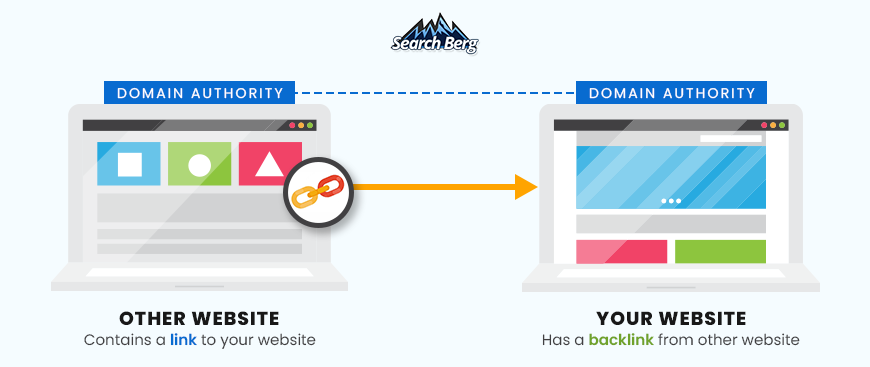
As a dentist, you should have a razor-sharp focus on building high-DA backlinks that help your business generate greater online visibility.
When some of the leading names in the healthcare industry (Mayo Clinic, WebMD, Healthline, etc.) cover dental topics and provide a link to your content, a swarm of their audience will flock to your website. Once this starts happening frequently, your dental business will become a common sight on SERPs and achieve significant growth.
Sounds like a plan? Let’s get you there!
We’ve covered the basics; it’s time to dive into the deep end.
What Kind of Backlinks Should I Target?
There are many types of backlinks; some are useful, some yield poor results, and some can get you penalized.
As a dentist, you must proceed with caution. While every business has a lot on the line, dentists, doctors, lawyers, professors, and similar professions are at greater risk. If you start using black-hat SEO practices, your reputation, qualifications, expertise, experience, and skillset will be questioned and denigrated.
The wrong kind of backlinks fall under the black-hat SEO umbrella. Tread with caution, do your research, work with an expert, and generate high-quality backlinks that benefit your business.
Focus on building the following backlinks:
1. Editorial Backlinks
Editorial backlinks are extremely common in the dental industry. These backlinks are embedded in high-quality, relevant, and authoritative material, e.g., press releases, online journals, reputable publications, etc.
You’ll earn an editorial backlink when your content (blog, article, infographic, video, etc.) is mentioned, or someone from your team (you, your dental assistant, the anesthesiologist, etc.) is quoted.
Online journals and publications don’t always include links. Your content may be mentioned in the bibliography without an official hyperlink.
This will still benefit you. However, in this case, we recommend reaching out to the journal/publication, thanking them for highlighting your work, and requesting an official backlink.
Here’s an example of an editorial backlink in a press release on PRWeb:
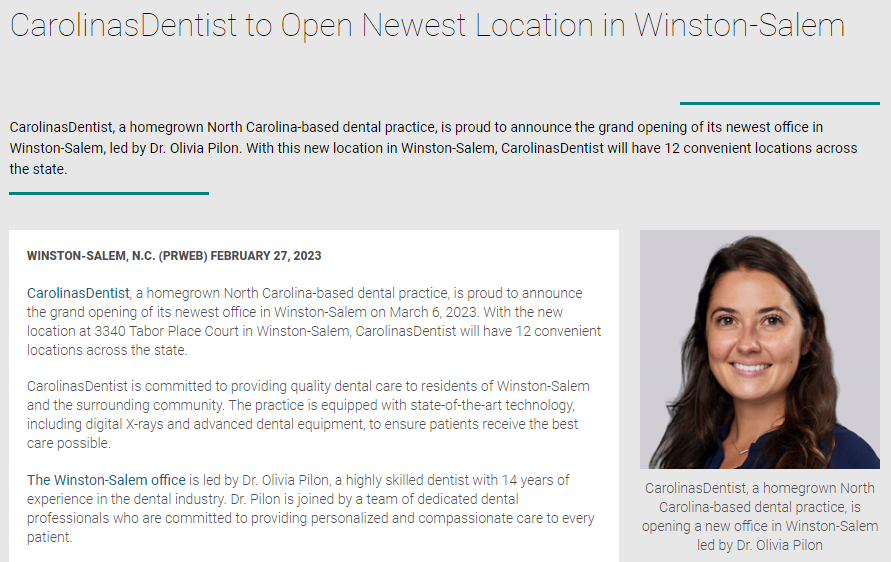
Recommended Read: A Quick 8-Step Backlink Audit Guide
2. Backlinks From Guest Blogs
Guest blogging is your golden ticket to acquiring high-DA backlinks that give your business the ammo it needs to get ahead. Now, backlinks from guest blogs aren’t always the panacea they’re made out to be. If you write a guest blog for a low-DA website, chances are it’ll do little to nothing for you.
However, you can’t always start off great. If your dental practice is new and inexperienced, you can’t expect backlinks from the top dogs right off the bat. A high-DA website will rarely link to a low-DA website (unless its content truly blows them away).
Do just that; up your quality game. Write for medium-DA websites and work your way upwards. Once you get the hang of guest blogging, you can start crafting power-packed content that high-DA guest blogging platforms cannot turn down.
Since you’ll have a studier online reputation by then, the top dogs will recognize you. As a result, they’re more likely to offer you a shiny backlink.
Your guest blogs must satisfy Google’s E-E-A-T (Experience, Expertise, Authoritativeness, and Trustworthiness) requirements. How do you do this?
To check E-E-A-T off the list, make sure you hand the guest posting task over to experienced dentists who have expertise in the relevant topic and are capable of writing authoritative and trustworthy content.
In addition to having dental prowess, they must also have a mastery of SEO. Tall order, eh? While you’ll have to put a little more effort into finding the right person for the job, the legwork will pay off.
Recommended Read: Google’s New E-E-A-T Explained: How to Master the Update
Moreover, dentistry falls under the category of ‘Medical Advice’ in Google’s YMYL (Your Money or Your Life) topics. Since your website and content offers advice or information that can impact someone’s health, the quality standards are high for your content.
YMYL content needs to satisfy the highest level of E-E-A-T and adhere to healthcare content guidelines.
Find guest blogging opportunities by running hyper-specific Google searches. Use a primary keyword (dentists, dental practice, etc.) and follow it up with the right search terms.
Here are some examples:
- [primary keyword] guest post
- [primary keyword] guest posting
- [primary keyword] guest post opportunities
- [primary keyword] write for us
- [primary keyword] guest article
- [primary keyword] this is a guest post by
- [primary keyword] contributing writer
- [primary keyword] submit guest post
- [primary keyword] contribute to our site
- [primary keyword] submit an article
- [primary keyword] contributor guidelines
- [primary keyword] accepting guest posts
- [primary keyword] become a guest writer
- [primary keyword] become a contributor
See what we mean? The primary keywords must be researched beforehand; don’t let guesswork lead the way. High-DA backlinks earned through guest posts will give your practice a power-packed boost.
Here’s an example of a guest posting backlink from a guest post submitted to Cosmetic Dental Treatments:
Recommended Read: Why Your Guest Blogging Strategy Is Failing
3. Directory Backlinks
If you want to steer your business in the right direction, turn to directory listings for dentists.
Web directories are well-crafted, well-organized, and comprehensive online catalogues/lists of businesses and their respective websites. They’re extremely useful from the link building standpoint.
However, like everything else, directories aren’t always equally beneficial. If you earn directory backlinks from low-quality directories, your dental business will not benefit in any way. In fact, you may get penalized if the backlinks arrive in swarms.
In 2023, Google’s algorithm is smarter than it’s ever been. No matter how smart and sneaky someone is, they can’t get past Googlebot and human quality raters.
Avoid black-hat directory link building and turn to trusted, reputable, and reliable directory listings for dentists. Take some time to find directories that are relevant to your practice, services, and location.
Here are some of the leading directories to list your dental practice on:
- The American Academy of Cosmetic Dentistry (AACD)
- The American Dental Education Association (ADEA)
- The American Academy of Pediatric Dentistry (AAPD)
- The American Dental Association (ADA)
- 1-800-DENTIST
- Clinic Search
- Cosmetic Dentist Directory
- USA Dentist
- Free Dental Care US
- CareDash
- Smile Guide
- Dental Clinics
- OpenCare
- Ortho Pages
- eHealth Scores
- FSNHospitals
- Delta Dental
- Wellness Directory
- Dental Plans
Most directories ask aspiring members to submit their dental practice’s full name, logo, website URL, photos, phone number, physical address, email address, working hours, specialization, year of inception, primary category, and business description.
Now, you can either take the reins yourself or hire a company that uses cutting-edge software and artificial intelligence (AI) to take care of all the legwork for you. We recommend the latter.
If you manually build directory listings, you’re asking for a decent amount of stress and frustration. The process isn’t easy; it requires a lot of time, consistency, and attention to detail. Automating this task is a great way to get rid of the hassle and save manual labor for other critical tasks that cannot be automated.
You can always get back in the front seat whenever you want. However, starting off, you can’t afford to kick things off on the wrong foot. Work with dental link building professionals who can help you generate high-quality dental backlinks with ease and adroitness.
This is what directory listings look like on AACD:
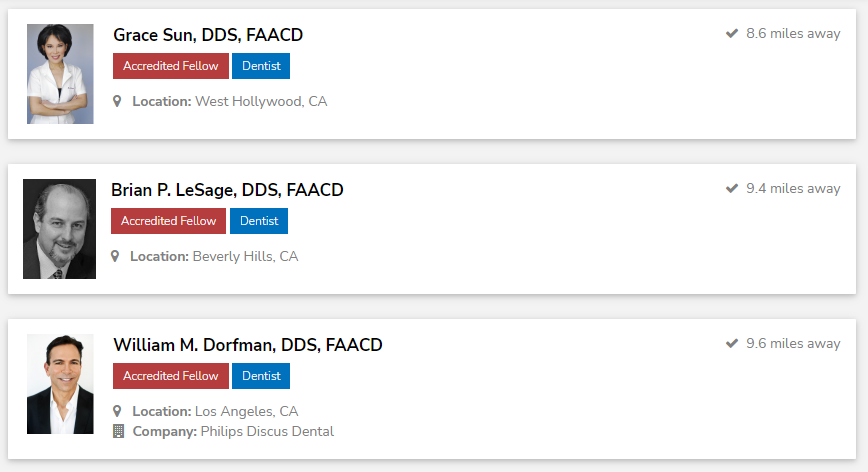
Once you open the listing, it’ll provide basic information about the business:
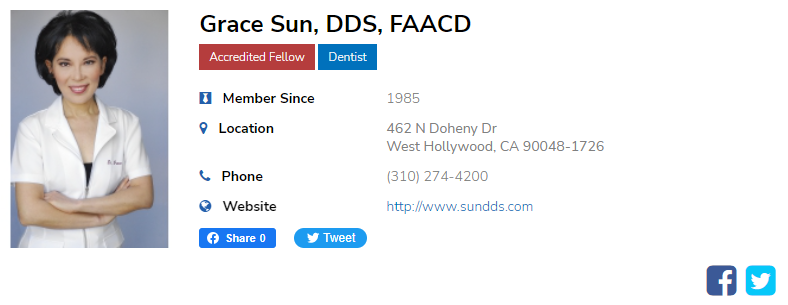
4. Comment Backlinks
When a business comments on a blog, they’re normally allowed to provide a link to their website. This is known as a comment backlink.
Unfortunately, this practice is generally frowned upon because it’s often misused. Spammers exploit comment link building by leaving a trail of copy-pasted comments across hundreds of blogs.
This is everything that Google stands against. If you resort to this tactic, your website will eventually get penalized, and your SERP rankings will drop.
Comment backlinks aren’t gimmicky by definition. In fact, they’re great (as long as you use them correctly). Leave genuine, original, and relevant comments on high-DA blogs. Avoid leaving a comment just for the sake of it. Instead, focus on providing value to readers and seal the deal with a link that takes them back to your page.
This technique will only work well when you leave insightful comments that bring new ideas to the table and start a thought-provoking conversation.
Appreciate the blog for the value it provides and add something that supplements a point already mentioned in the blog. When you cover new facets, people will feel compelled to read your comment all the way through and explore your website.
Moreover, the website itself will take notice and offer you a guest posting opportunity (if they accept guest blogs) or, at the very least, acknowledge your efforts.
While building high-DA backlinks is important, it’s not always the ultimate goal. In some cases, receiving unlinked acknowledgment from the biggest names in your industry is pretty neat as well. This is a great way to establish trust and authoritativeness.
Use comment backlinks wisely and strategically to propel your dental business forward. Each comment should be 100% original and unique. Once you start leaving value-added comments, your online presence will start shaping up.
Let’s look at an example. New Dentist Blog recently published a blog titled “Emotional Intelligence Is Still a Vital Skill for New Dentists.”
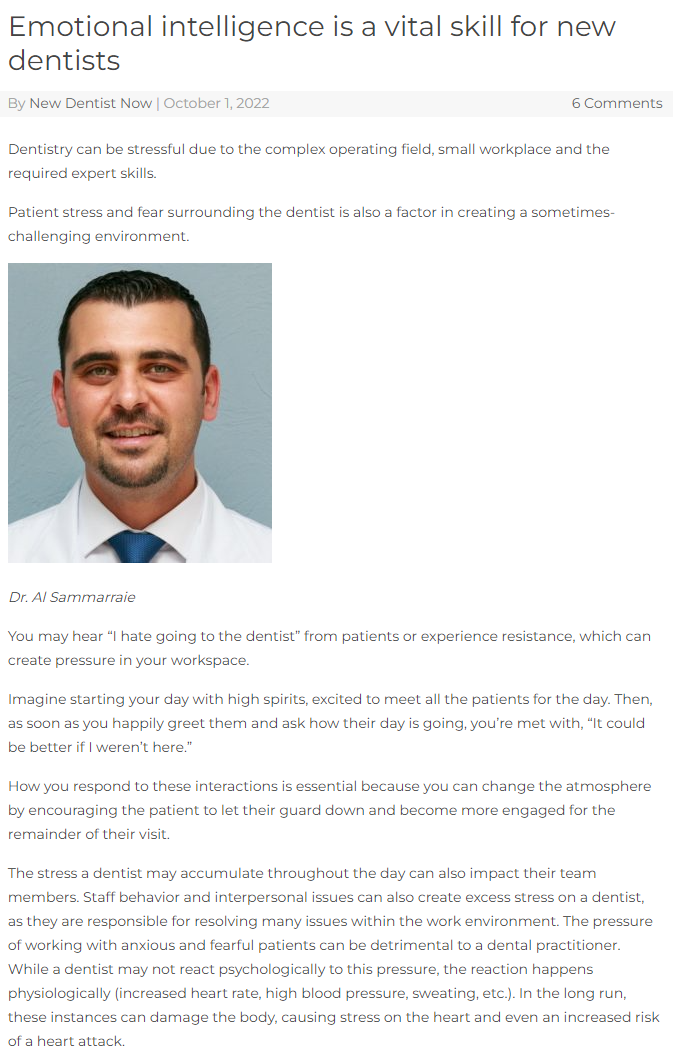
Keep scrolling until you reach the comments section. Notice something? The blog has earned a handful of comments, some of which provide immense value to the audience. These two stand out to us:
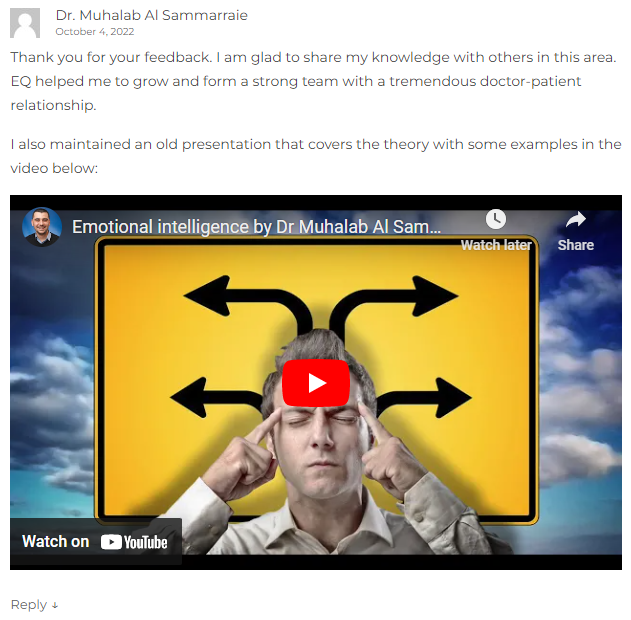
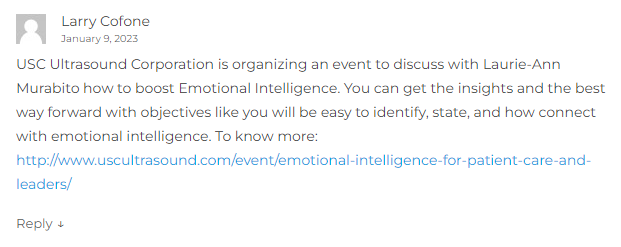
Each of these contributors has shared a link to their content. Even if a link wasn’t provided, users could still click on their profile and access their business.
The first commenter promotes a video, while the second takes this opportunity to promote their upcoming event on emotional intelligence.
You don’t have to leave a long comment each time. As long as you provide value within a few sentences, you’re good to go.
Recommended Read: What Is HARO and How to Use It for Backlinks
5. Citations
If you haven’t turned your attention to citation building for dentists yet, it’s time to jump on the bandwagon.
Citations allow businesses to add their name, address, phone number (NAP), and domain link to a web directory. They’re very similar to regular directory listings for dentists. However, they also require you to provide your NAP.
Now, citations aren’t always hyperlinked. Think of them as online mentions; they may or may not be linked.
Yelp is a great example.
Let’s say you’re looking for the best dentists in California. If you run this search on Google, the results will include Yelp listings. Something like this will catch your eye:

This is a citation. Citations are incredibly useful for local businesses. Unless you provide telehealth services, chances are that your dental business is local. This is why citations are a lifesaver for you. Your business will start showing up on Google SERPs and earn more patients.
You can also build structured citations on:
A structured dental citation is very similar to what you’d find in a directory. You have full control over what goes on your page. Here is an example of a structured dental citation on Yelp:
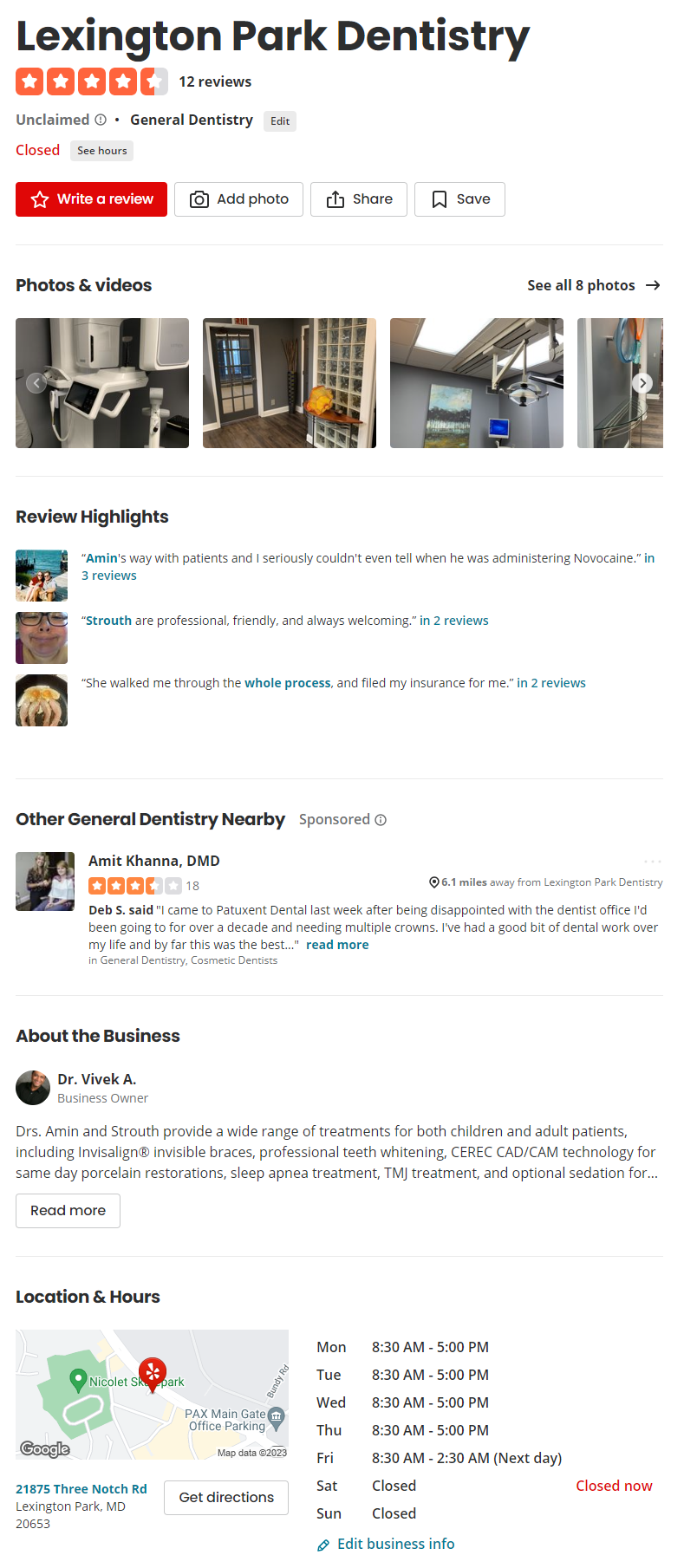
Unstructured citations, on the contrary, are found on websites that aren’t business directories, e.g., magazine/newspaper websites, social media posts, blogs, review sites, etc.
Here’s an example of an unstructured dental citation found on a news website:

Once your business develops a good reputation in your local community, you’ll start building organic unstructured citations.
While this citation doesn’t include a hyperlink, it’s still extremely useful. Notice how the dental clinic’s number is listed towards the end. Yes, people can’t click on the number and make a direct call without any effort. However, the article is so touching that they wouldn’t mind doing a bit more legwork.
When your dental business is continually under the limelight for all the right reasons, people will feel compelled to go the extra mile to contact you. This is why unstructured citations are imperative.
Both structured and unstructured citations will help you strengthen your brand identity and polish your clinic’s reputation.
Citation building for dentists isn’t exactly a piece of cake. Start off slow. Work with experts to find the right platforms and improve your public relations efforts. Consistency will ultimately help you check this box off the list like a seasoned pro.
Recommended Read: How to Get Published on Yahoo News
Should I Avoid Paid Dental Backlinks?
Let’s address the elephant in the room.
Paid backlinks are a big no. And yes, they can get you in trouble sometimes. When Google realizes that you’re using paid links to mess with the algorithm, your site may be removed from the index entirely.
However, it’s important to note that paid backlinks aren’t always the bad guy they’re made out to be. Let’s quickly understand why.
According to Google’s Webmaster Guidelines, there’s nothing long with paying for links as long as you’re honest about it. If you’re using a paid link, make sure you use robots.txt, rel=”nofollow” or rel=“sponsored” to ensure that the paid links aren’t followed by crawlers. If you don’t do this, you’ll get in trouble.
However, paid backlink usage is acceptable when it’s done transparently and honestly.
Unfortunately, many businesses flout the rules because disclosed paid backlinks don’t really do much for you. This is where the repercussions start.
If you want to err on the side of caution, avoid paid backlinks entirely. However, if you can use them responsibly and truthfully, you have nothing to worry about.
Does Dental SEO Set Your Teeth on Edge? We’ll Handle It!
SEO isn’t everyone’s cup of tea.
If you’re having trouble launching a robust in-house SEO plan and sustaining good results, turn to the pros for help.
At Search Berg, we specialize in SEO for dentists. By injecting link building into our SEO plans, we ensure that your dental business dominates Google SERPs, earns a power-packed boost in online visibility, and turns more visitors into patients.
Let’s begin!














